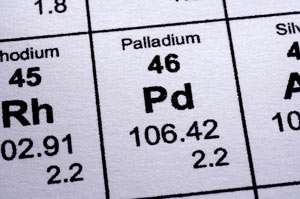Innovative molecule helps palladium catalyst create complex compounds

A robust palladium catalyst developed by A*STAR researchers now offers the best way to couple certain forms of carbon-based molecules. The products of these reactions have chemical structures that are found in common pharmaceuticals, and the acclaimed catalyst is already commercially available.
The catalyst helps unite two types of organic chemical—aryl chlorides and alkynes—to generate a substituted alkyne. This structure is found in functional molecules such as tazarotene, a drug to treat psoriasis and acne. "We are essentially developing a tool for molecular assembly," says Howard Jong of the A*STAR Institute of Chemical and Engineering Sciences, who led the research, along with his colleague Yong Yang.
The key component of the catalyst is the attached ligand, Cy*Phine, which is a phosphine-based molecule that is coordinated to the palladium center and controls reactivity; ligand properties directly influence how the catalyst interacts with other molecules during the reaction. Importantly, Cy*Phine contains an innovative chemical framework known as a meta-teraryl group, based on a chain of three benzene rings, which is designed to inhibit unwanted side reactions.
The team had previously made the catalyst by adding its precursors separately to the reaction mixture. More recently, they have pre-formed the catalyst as a yellow solid that is stable in the presence of air and moisture. Using such precatalysts tends to enable more reproducible results. Once in solution, Jong notes, the precatalyst is reduced, losing its two chloride atoms, and likely, one of its Cy*Phine units to become active.
The researchers tested their precatalyst under different conditions, and found that it worked best in a solvent called acetonitrile, along with a small amount of potassium phosphate.
The catalyst produced with this recipe gave much better results than other state-of-the-art commercial catalysts for the coupling reaction. It could connect a wide variety of different aryl chlorides and alkynes and mostly produced very high yields of the substituted alkyne product. It even worked well with electron-rich reactants, which other palladium catalysts have failed to couple in good yields. The team also found that adding an electron-donating group to the meta-teraryl group made the reaction run a little faster, although there was no increase in overall yield.
The palladium precatalyst and the Cy*Phine molecule are now being sold by Aspira Scientific. "Third parties who have extensively tested our products are extremely impressed," says Jong. "We are encouraged by their responses and are hopeful our catalysts will continue to do well in the marketplace."
More information: Yong Yang et al. Palladium precatalysts containing meta-terarylphosphine ligands for expedient copper-free Sonogashira cross-coupling reactions, Catal. Sci. Technol. (2015). DOI: 10.1039/c5cy00507h




















